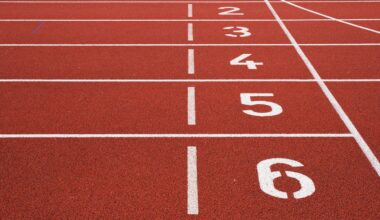Analyzing Competition Data to Enhance Coaching Decisions
In track and field coaching, analyzing competition data is indispensable. Coaches can enhance their strategies by evaluating athlete performance accurately. Data analysis allows for better decision-making regarding training regimens, competition strategies, and athlete development plans. To start, coaches should gather comprehensive data from competitions that include personal bests, weather conditions, and competitor statistics. This information provides insight into what strategies may work best based on environmental conditions. For instance, wind speed might significantly affect sprinting times or long jump distances. Coaches who regularly analyze this data can adapt training sessions focused on specific areas of improvement. Moreover, using video technology can supplement the analysis by providing visual feedback on technique and performance. Such feedback can pinpoint areas where an athlete might be losing efficiency or speed. The collection and analysis should not be a one-off event but rather an ongoing process throughout the sporting year. Coaches must provide athletes with constructive feedback based on this data so they consistently improve. Over time, this process fosters a more informed approach to coaching, elevating performance in track and field disciplines.
Another critical aspect of analyzing competition data is the establishment of benchmarks for athletes. Creating performance benchmarks helps in pinpointing the strengths and weaknesses of each athlete. These benchmarks can be based on the athlete’s past performances or the average performances of competitors. Gathering data from various competitions enables coaches to identify trends in an athlete’s progression over time. Utilizing software tools that can track and analyze this data allows coaches to visualize performance metrics and trends effectively. This insight can lead to individualized training programs tailored to each athlete’s needs. For example, a coach might notice that an athlete performs better under certain weather conditions or against particular competition levels. This information can help in scheduling competitions optimally, ensuring peak performance during critical events. In addition, analyzing competitor data can provide a competitive edge when planning for specific events. Coaches can research opponents by studying their past performances, strengths, and weaknesses. Preparing athletes for these insights leads to more personalized coaching strategies that enhance overall competitiveness.
Utilizing Technology in Performance Analysis
Technology plays a fundamental role in performance analysis for track and field coaching. Wearable technology, such as GPS trackers and heart rate monitors, is increasingly popular among athletes and coaches. These devices collect real-time data during training and competition, allowing coaches to understand the physical demands placed on their athletes. Analyzing this information can reveal patterns that help coaches optimize training loads and recovery strategies. For instance, monitoring heart rate variability can help determine when an athlete is ready for hard training sessions or when they need to rest. Furthermore, motion analysis software can track velocity and biomechanics, providing essential feedback on performance. With video analysis tools, coaches can slow down footage of competitions to analyze an athlete’s form and technique in detail. Such tools provide precise insights into stride length and frequency, allowing for targeted improvements. Integrating these technologies into the coaching process fosters a data-driven culture. This culture encourages athletes to embrace technology, enhancing their engagement and commitment to training regimens.
Furthermore, data-driven coaching fosters effective goal-setting for track and field athletes. By thoroughly analyzing both historical and current competition data, coaches can set achievable yet challenging goals based on quantitative metrics. For example, if an athlete’s current performance level is consistently below their personal records, data can help identify specific areas to target for improvement. Coaches can create short-term and long-term goals focused on enhancing aspects such as speed, technique, or strength. Importantly, goal-setting should involve the athlete’s input, ensuring their motivation remains high. When athletes understand how their goals are shaped by data, it reinforces their purpose and direction in training. Additionally, regular assessments against these goals allow for ongoing adjustments. If athletes make significant progress, goals may need to be reevaluated, ensuring they remain relevant and attainable. This adaptability in coaching ensures that athletes are always advancing and not plateauing in their performances. Moreover, setting precise goals can foster a sense of accomplishment and encourage athletes to embrace the journey of improvement.
The Role of Mental Preparation
Mental preparedness is equally vital in track and field coaching, influencing performance during competitions significantly. Analyzing competition data provides insights not only into physical attributes but also into psychological readiness. Data analysis can be instrumental in establishing mental benchmarks for athletes as they prepare for different competitions. For instance, by evaluating past performance under pressure situations, coaches can identify the mental strengths and weaknesses of their athletes. Incorporating mental training strategies can enhance an athlete’s focus, confidence, and composure. Visualization exercises, goal-setting practices, and mindfulness techniques can all be integrated into the training regimen. Coaches can leverage data to track these mental training activities’ effectiveness and adapt them to suit individual athlete needs. Understanding factors that may cause anxiety or stress during competitions offers additional actionable insights. Coaches can tailor preparation activities leading up to competitions, ensuring athletes are equipped to face pressure. Additionally, maintaining a healthy team environment boosts morale and fosters emotional resilience. Recognizing the intersection of data analysis and mental performance ultimately creates a more holistic coaching approach.
Moreover, effective communication strategies are crucial to translating data analysis into actionable coaching decisions. Disseminating complex data in an understandable manner ensures that athletes can grasp the insights and implement them. Coaches should utilize various communication methods to cater to different learning styles, such as visual aids, direct conversations, and written reports. Additionally, involving athletes in this data interpretation fosters greater ownership of their training processes. By fostering open discussions about competition data, athletes may feel more empowered to ask questions and provide feedback. Coaches can also encourage an environment where athletes share their experiences, enhancing mutual learning. Building these relationships facilitates a culture of continuous improvement. Moreover, consistency in communication throughout the training cycles creates a foundation of trust, which is essential for a successful coach-athlete dynamic. When athletes understand that their coaches value data-driven decision-making, they are more likely to respect and adhere to the training plans provided. Ultimately, effective communication fosters a collaborative approach to coaching, enhancing overall team performance.
Conclusion
In conclusion, analyzing competition data is pivotal for enhancing coaching decisions in track and field. With a comprehensive approach that integrates physical performance analysis, mental preparation, and effective communication, coaches can create tailored training programs. Data analysis not only informs athletes of their current performance levels but also plays a crucial role in establishing clear goals and benchmarks. Implementing technology improves the accuracy of data collection and streamlines feedback processes. Moreover, fostering a supportive coach-athlete dynamic facilitates an environment of trust, making it easier to integrate constructive feedback into training. As the sports landscape evolves, leveraging competition data should no longer be optional, but rather an integral part of every coaching philosophy. Embracing technology and innovative analysis methods allows teams and individuals to gain a competitive edge, ultimately enhancing performance at critical competitions. Coaches equipped with the right tools and insights are better positioned to guide their athletes toward success. Only with a holistic approach to data analysis can coaching in track and field remain adaptive, informed, and impactful in an increasingly competitive environment.






